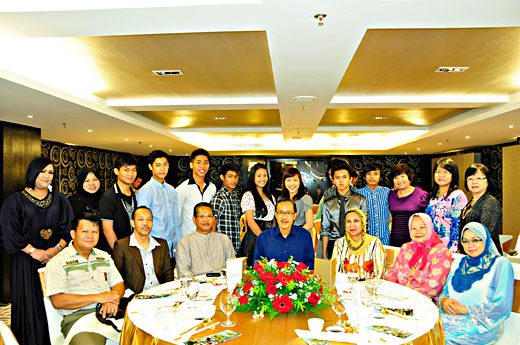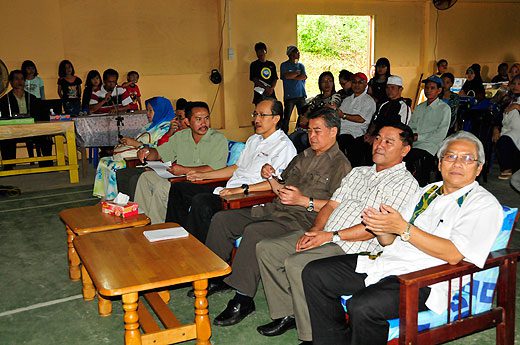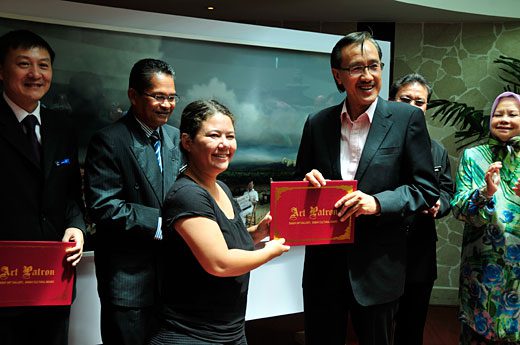Captive breeding last hope for rhinos
Sumatran rhino numbers have plunged so low that if captive breeding is not done now, the species might well tip over the brink. SHE has difficulty moving and hobbles pitifully around her enclosure in a special sanctuary in Sabah. Her left forefoot is just a stump – it was caught in a snare when she was a calf. So they named her Puntung, Malay for “stump”.
Her handicap had prevented her from actively foraging for food, which explains her skinny frame – the lines of her rib cage show through her torso.
“With only three good legs, she can’t move far in the forest. She can’t reach for a lot of food, she can only browse. She has lacerations on her neck and hind leg and is badly scarred, indicating how tough a time she must have had in the forest,” says veterinarian Dr Zainal Zahari Zainuddin.
Thankfully, Puntung, a female Sumatran rhinoceros, is now safely esconced at Borneo Rhino Sanctuary, a 4,500ha sprawl of forest within Tabin Wildlife Reserve, some 45km from Lahad Datu in eastern Sabah.
Late last year, news of her capture made headlines all over the world. She was trapped on Dec 18 in another part of Tabin and on Christmas Day, airlifted by helicopter to the sanctuary. In her new home, she is showered with attention. She has her own paddock and workers feed her with leaves from different trees and occasionally shower her with water to keep her cool.
All that pampering is with a purpose – Puntung is to be nursed back to health so that she can mate with Tam, short for Kretam, a male rhino at the sanctuary. The pair promises wildlife biologists another shot at breeding the critically-endangered species in captivity; it is a last-ditch attempt to save a species which is staring at extinction.
The Sumatran rhinos (or Asian two-horned rhino, Dicerorhinus sumatrensis) are dying out as their habitat has dwindled, they are shot for their horns and increasing isolation hinders their breeding. Surveys of known rhino strongholds Taman Negara, Royal Belum State Park and Endau-Rompin National Park in recent years showed no evidence of rhinos, causing some within the wildlife conservation fraternity here to believe that the animal is all but poached out in Peninsular Malaysia.
In Sabah, the population is down to less than 40, which makes the state our only hope of preventing local extinction of the species. (The only other place which harbours the species is Sumatra, which has an estimated population of 150.)
The loss of the rhino is not a modern-day occurrence. They were already being hunted in the 1900s. Vetting old newspapers on Sabah, wildlife biologist Dr Junaidi Payne finds that rhinos were routinely hunted in the early 1900s, during which 20 rhino horns were exported annually. From the 1960s to the 90s, the hunt continued as people still coveted rhino horns as folk remedies, plus there was an added threat – loss of rhino habitat as forests were cleared for timber and conversion to human settlements, farms and plantations.
Today, major deforestation has slowed down somewhat, so loss of habitat is no longer the main threat to rhinos, according to Payne. Rather, it is their dwindling numbers and isolation which prevent breeding, stifling any possibility of expanding the population. Which is why a group of wildlife conservationists has formed the Borneo Rhino Alliance (Bora) to spearhead a captive breeding programme at Tabin, as a last recourse for the species.
“The problem now is that most remaining rhinos are infertile and too old to breed, and too scattered to meet and breed,” says Payne, executive director of Bora. “Most are solitary, just living out their lives. When a species declines to such low numbers, the only way to boost numbers and birth rate above death rate may be to bring some individuals together to increase the prospects for breeding. “Some people say the way to protect them is in the wild. We did that in the 80s, but the numbers still went down. Clearly (just) protecting and monitoring rhinos is a recipe for witnessing their extinction. So, there is only one priority, which is to make them breed.”
In the case of Puntung, she is unlikely to breed in the wild as monitoring work since 2007 shows that she never leaves her 15sqkm territory and no males venture there either; hence a decision was made in late 2009 to trap her.
Unsuccessful mating
Catching endangered wild animals to breed them in captive conditions is controversial but Payne points out that that was exactly how and why the African and Indian rhinos did not go extinct in the late 19th and early 20th centuries. Nonetheless, wariness lingers over the practice as past attempts, thwarted by poor husbandry and uncertainties, saw little success.
Between 1984 and 1994, 40 rhinos were captured in Sumatra, Peninsular Malaysia and Sabah under an International Union for Conservation of Nature-led rhino rescue project. The animals ended up in European and American zoos, and in breeding facilities in their home states.
Most, however, fared badly in captivity and died from various diseases and old age. (In hindsight, the experts 30 years ago did not know enough about the rhino’s nutritional needs and reproductive health. In the wild, rhinos eat some 200 species of leaves, some of which contain compounds which bind iron. In captivity, the diet is not as varied, leading to iron accumulation and eventually, diseases.)
Of the 40 rhinos, only one pair, in Cincinnati Zoo in Ohio, the United States, bred and produced three babies. The animal keepers there got the care and the diet right and so, were successful. One of the captive-bred males, Andalas, was returned to Indonesia in 2007 to join three other females at the rhino sanctuary in Way Kambas National Park in Sumatra. The female, Ratu, is now pregnant and due to deliver in July, having miscarried twice before.
In Peninsular Malaysia, captive breeding efforts at the Sungai Dusun Rhino Conservation Centre in Selangor saw no success and ended abruptly in late 2003 when all five remaining rhinos died over a span of 18 days from bacterial infection caused by unkempt conditions. In August 2006, the sole captive male rhino in Sabah then was killed by a falling tree branch at the breeding centre located within the Orang Utan Rehabilitation Centre in Sepilok, Sandakan. This left the female rhino, Gelogob, without a mate. The breeding programme was doomed until 2008, when Tam was found in an oil palm plantation and trapped.
Past failures in captive breeding were partly because the biology of wild rhinos had conspired against them. Many of the captive rhinos had reproductive pathology associated with long non-productive periods. Many were too old and not fertile, and the females had cysts in their ovary tracts while the males had low sperm count. Sabah Wildlife Department veterinarian Dr Senthilvel Nathan explains: “When animals are sexually inactive and have not mated, their hormonal system is affected, they get reproductively unsound.”
Such is the tragic story of Gelogob, the sole survivor of the 1984-1994 capture programme. She was fertile in 1994 and showed signs of having given birth but by the time Tam was trapped and paired with her, Gelogob was no longer in her prime and her pregnancy did not come to term. Today, she is too old to breed and treatment to promote ovulation has not worked.
Breeding science
At the new rhino sanctuary in Tabin, however, wildlife biologists are optimistic about current breeding efforts as advances in reproductive science mean more options are available. Fussed over by attentive staff, Puntung has piled on over 7kg since her arrival and now weighs close to 500kg. Her enclosure is separated from, but is next to Tam’s, so that they can get familiar with each other’s scent. Puntung now has her own 1,000sqm paddock and this will slowly be enlarged to include the forested area where she can roam. She will be given time to get used to her new environment, before any breeding attempts can start.
Dr Zainal keeps a close watch over Puntung. Her blood is being tested for progesterone levels to determine her reproductive health. “I’m quite certain that her reproductive system is healthy as she’s young, around 10 to 12 years old,” says the Bora field manager. Enclosures are also sanitised – even the pellets fed to the rhinos are tested for fungus – to prevent a repeat of past mishaps of captive rhinos dying from infections triggered by unhygienic conditions.
Three to four months of blood sampling will be needed before the Bora team can decide on the most suitable breeding method to employ, either natural means or advanced reproductive methods such as artificial insemination and in vitro fertilisation. Ultrasound scans will enable Zainal to know when the animals are in heat and can be brought together to mate.
But there is a potential snag: Tam’s virility appears to be on the decline. “Tam is producing semen but in small amounts and not of good quality,” says Zainal. “This could be due to many factors. We’re doing electro-ejaculation, and this will give various results as you’re forcing the animal to ejaculate. The best is ejaculation through natural means. He used to give good semen in 2009 and then it fluctuated; it could be due to stress or age (Tam is about 20 years old).”
To beef up chances of success, foreign experts experienced in breeding rhinos are lending their expertise. Dr Jorg Junhold, director of Germany’s Leipzig Zoo, says artificial insemination was first successfully used for elephants eight years ago and can be tried out on rhinos. The zoo has a long history of keeping African rhinos and has bred the black rhino. “In principle, there are a lot of parallels in the keeping of different species of rhinos, which is why Leipzig Zoo is partnering and funding the project here, so we can add our experience to keeping rhinos.”
Will it make a difference?
There is also a plan to cryopreserve sperm from Tam for possible impregnation of captive female rhinos from either the peninsula or Sumatra. (In the past, all three rhino range states worked independently of each other, due to a belief that the Sabahan population is a sub-species. This has since been disputed based on DNA work and scientists now agree that rhinos from all three sites should be managed as one conservation unit.)
But even if Tam and Puntung were to produce an offspring, would it make any difference to the survival of the species in the wild? Will it be enough to rejuvenate the dwindling population? With their already small numbers, the slow-breeding rhinos – they have a gestation period of 15 months and a birth-interval of three years – are unlikely to reproduce fast enough to repopulate their own kind.
Payne disagrees: “There are a few fertile rhinos left, so they can be saved if brought together. People say they’re so inbred, is it worthwhile? Several species including the American bison, African and Indian rhinos and Arabian onyx got very, very low in numbers because of people slaughtering them in the late 19th century. Those went down to tens, less than a hundred. But people got together and put them in paddocks and the animals bred and those species are still alive. They may be inbred but they’re still there.”
Recent months have seen dismal news about the world’s rhinos: in October, the Javan rhino was declared extinct in Vietnam, its last range in mainland Asia (the last Javan rhino in Peninsular Malaysia was shot in 1932). Shortly after, in November, the International Union for Conservation of Nature announced the extinction of the western black rhino in Africa.
It also warned that a sub-species of the white rhino in central Africa, the northern white rhino, is teetering on the brink of extinction and has been listed as “possibly extinct in the wild”. The Sumatran rhino appears to be heading down the same path, if we do not act fast enough.
“This species is on the edge of extinction,” says Payne. “There is a chance to save an animal that started off millions of years ago, but that chance will be lost within this decade if sustained action is not taken now.”
Source: The Star (By TAN CHENG LI)




 The Maktab Sabah Secondary School Arts Group dinner reception with YB Datuk Masidi Manjun in attendance, on the 19th of February 2012 at Ming Garden Hotel & Residences.
Majlis Makan Malam Kumpulan Kesenian Sekolah Menengah Maktab Sabah bersama dengan YB Datuk Masidi Manjun pada 19 Februari 2012 bertempat di Ming Garden Hotel & Residences.
The Maktab Sabah Secondary School Arts Group dinner reception with YB Datuk Masidi Manjun in attendance, on the 19th of February 2012 at Ming Garden Hotel & Residences.
Majlis Makan Malam Kumpulan Kesenian Sekolah Menengah Maktab Sabah bersama dengan YB Datuk Masidi Manjun pada 19 Februari 2012 bertempat di Ming Garden Hotel & Residences. YB Datuk Masidi Manjun attends the ‘Pemimpin Bersama Rakyat’ programme at Kg. Langkau, Ranau on the 11th of February 2012.
YB Datuk Masidi Manjun ketika menghadiri program Pemimpin Bersama Rakyat di Kg Langkau Ranau pada 11 Feb 2012.
YB Datuk Masidi Manjun attends the ‘Pemimpin Bersama Rakyat’ programme at Kg. Langkau, Ranau on the 11th of February 2012.
YB Datuk Masidi Manjun ketika menghadiri program Pemimpin Bersama Rakyat di Kg Langkau Ranau pada 11 Feb 2012.
 YB Datuk Masidi Manjun attends the Launching Ceremony for the Visual Arts Patron and Signing of Memorandum of Understanding (MoU) between the Sabah Cultural Board and Ming Garden Hotel & Residences on the 15th of February 2012 at the Atrium, Level 1, Ming Garden Hotel & Residences, Kota Kinabalu.
YB Datuk Masidi Manjun ketika di Majlis Pelancaran Patron Seni Visual & Menandatangani Memorandum Persefahaman diantara Lembaga Kebudayaan Negeri Sabah dan Ming Garden Hotel & Residences pada 15hb Februari 2012 bertempat di Atrium Level 1, Ming Garden Hotel & Residences, Kota Kinabalu.
YB Datuk Masidi Manjun attends the Launching Ceremony for the Visual Arts Patron and Signing of Memorandum of Understanding (MoU) between the Sabah Cultural Board and Ming Garden Hotel & Residences on the 15th of February 2012 at the Atrium, Level 1, Ming Garden Hotel & Residences, Kota Kinabalu.
YB Datuk Masidi Manjun ketika di Majlis Pelancaran Patron Seni Visual & Menandatangani Memorandum Persefahaman diantara Lembaga Kebudayaan Negeri Sabah dan Ming Garden Hotel & Residences pada 15hb Februari 2012 bertempat di Atrium Level 1, Ming Garden Hotel & Residences, Kota Kinabalu.
